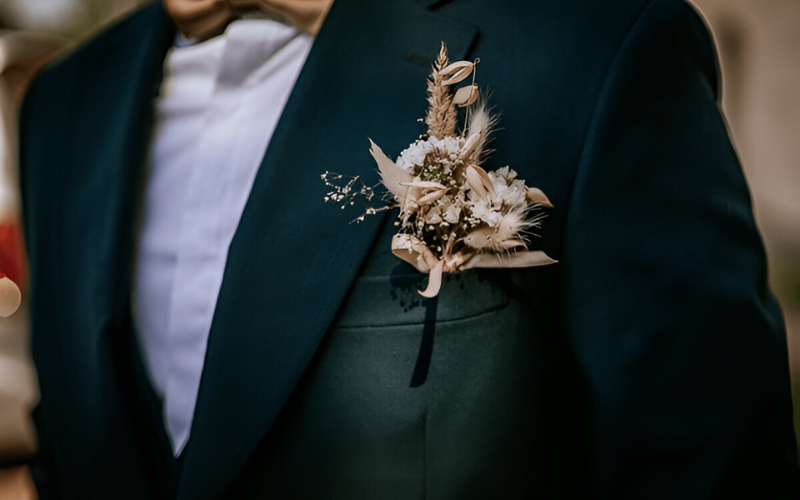Introduction
A boutonniere is more than just a decorative flower pinned to a jacket—it’s a symbol of style, tradition, and personal expression. Whether it’s worn at a wedding, prom, or formal event, this small floral accent can make a lasting impression. In today’s world of refined fashion and attention to detail, understanding the purpose, types, and etiquette of boutonnieres helps anyone look sharp and feel confident. This article will walk you through everything you need to know about boutonnieres—from their origin to how to wear one the right way.
What Is a Boutonniere?
A boutonniere (pronounced boo-ton-ee-air) is a small arrangement of one or more flowers worn on the lapel of a suit or tuxedo. Traditionally, it’s placed on the left side of the chest, over the heart, and secured through the buttonhole or with a pin.
Boutonnieres are most commonly worn at weddings, dances, and other formal occasions. They serve as a visual accent that complements the rest of an outfit—especially when coordinated with ties, pocket squares, or the overall color scheme. Although small in size, a boutonniere reflects personal taste, respect for tradition, and attention to elegance.
A Brief History of the Boutonniere
The history of the boutonniere dates back hundreds of years. Originating in the 16th century, men would often wear a single flower on their chest as a token of love or a symbol of good luck and protection. The word itself comes from the French language and means “buttonhole flower.”
In the 19th and early 20th centuries, boutonnieres became a staple in men’s formalwear, especially among the upper class. Gentlemen would often visit their florists before heading to social events to choose a fresh flower to tuck into their jacket lapel. Over time, this tradition evolved into a ceremonial gesture, especially at weddings and special celebrations.
Today, while not worn daily, the boutonniere remains a meaningful accessory that blends timeless tradition with personal flair.
When and Where Boutonnieres Are Worn
The boutonniere has its place in various life events—primarily formal and sentimental ones.
The most common occasion is a wedding, where the groom, groomsmen, fathers of the couple, and sometimes even close family members wear one. Proms and formal dances are also popular times for wearing a boutonniere, often coordinated with a partner’s attire or corsage.
Boutonnieres are also seen at:
- Award ceremonies
- Military balls
- Graduations
- Funerals (in some cultures)
As for placement, always pin the boutonniere on the left lapel, just above the heart. It should be upright and balanced—not drooping or sagging. The stem is usually hidden behind the lapel or pinned in place to avoid distractions from the overall look.
Understanding where and when to wear a boutonniere is part of modern etiquette. It shows that the wearer cares about tradition, appearance, and thoughtful dressing.
Types of Flowers Used in Boutonnieres
The flower used in a boutonniere isn’t random—it often carries meaning or matches the overall theme of the event.
Popular flower choices include:
- Rose: Classic and romantic, ideal for weddings
- Carnation: Durable and affordable, great for proms
- Calla Lily: Elegant and modern, often used for high-end ceremonies
- Orchid: Unique and luxurious, perfect for destination weddings
- Baby’s Breath or greenery: Often used as accents to add volume or softness
Each flower may symbolize something. For instance, a red rose often signifies love, while a white carnation might represent purity or remembrance.
Many people also choose flowers that match the color of their suit accessories, the event’s palette, or the season. In fall, you might see warm tones like burgundy and orange. In spring, pastels are more popular.
The goal is to make the boutonniere feel intentional—not just a last-minute decoration.
DIY vs. Florist-Made Boutonnieres
Creating a boutonniere yourself can be rewarding, but it’s not for everyone. Let’s explore both options.
Pros and Cons of Making Your Own
Doing it yourself allows for customization and creativity. You can hand-pick the flowers, materials, and colors to match your outfit or event theme. It may also be more cost-effective, especially for large groups like groomsmen.
However, it requires time, tools, and some floral knowledge. Fresh flowers need careful handling, and poorly made boutonnieres might wilt, fall apart, or be difficult to pin.
What to Expect from a Professional Florist
When you choose a professional, you get quality craftsmanship and reliability. Florists use the right materials—like floral tape and sturdy pins—and ensure the boutonniere stays fresh throughout the event. They also offer guidance on flower choices, colors, and coordination with the larger floral arrangements.
For important events like weddings, trusting a florist often brings peace of mind.
How to Properly Pin and Wear a Boutonniere
Wearing a boutonniere correctly ensures that it adds style—not stress—to your look.
Step-by-Step Guide to Attaching One
- Hold the boutonniere against the left lapel.
- The flower head should face outward, stem pointing downward.
- Insert a straight pin from the back of the lapel, going through the fabric, into the stem, and back through the fabric again.
- Make sure it’s secure and centered.
Some suits have a built-in boutonniere loop to help guide and hold the flower in place.
Common Mistakes to Avoid
- Don’t pin through the front of the lapel (it ruins the clean look).
- Don’t let the flower tilt or hang loosely.
- Avoid oversized or heavy flowers that weigh down the fabric.
Wearing a boutonniere properly enhances the overall appearance and ensures it stays in place throughout the event.
Conclusion
The boutonniere may be a small detail, but it carries rich meaning, tradition, and elegance. Whether you choose a rose for romance or a lily for sophistication, this simple floral piece helps mark life’s most important moments in style. Knowing when to wear it, how to choose it, and how to pin it properly gives you confidence and polish at any formal event.
FAQ
Q1: What side do you wear a boutonniere on?
Always wear it on the left lapel, over your heart. That’s the traditional and correct placement.
Q2: Can you wear a boutonniere without a jacket?
It’s possible, but not common. Boutonnieres are designed for lapels, so if you’re not wearing a jacket, consider a floral wrist corsage or pocket square instead.
Q3: How long does a boutonniere last?
A fresh boutonniere typically lasts 8–12 hours if kept cool and properly stored. Some use preserved or artificial flowers for longer events or destination weddings.
Q4: Is it okay to skip a boutonniere at a wedding?
Yes, it’s optional. While traditional, many modern weddings now skip boutonnieres or use alternatives like pins, brooches, or greenery for a minimalist look.

